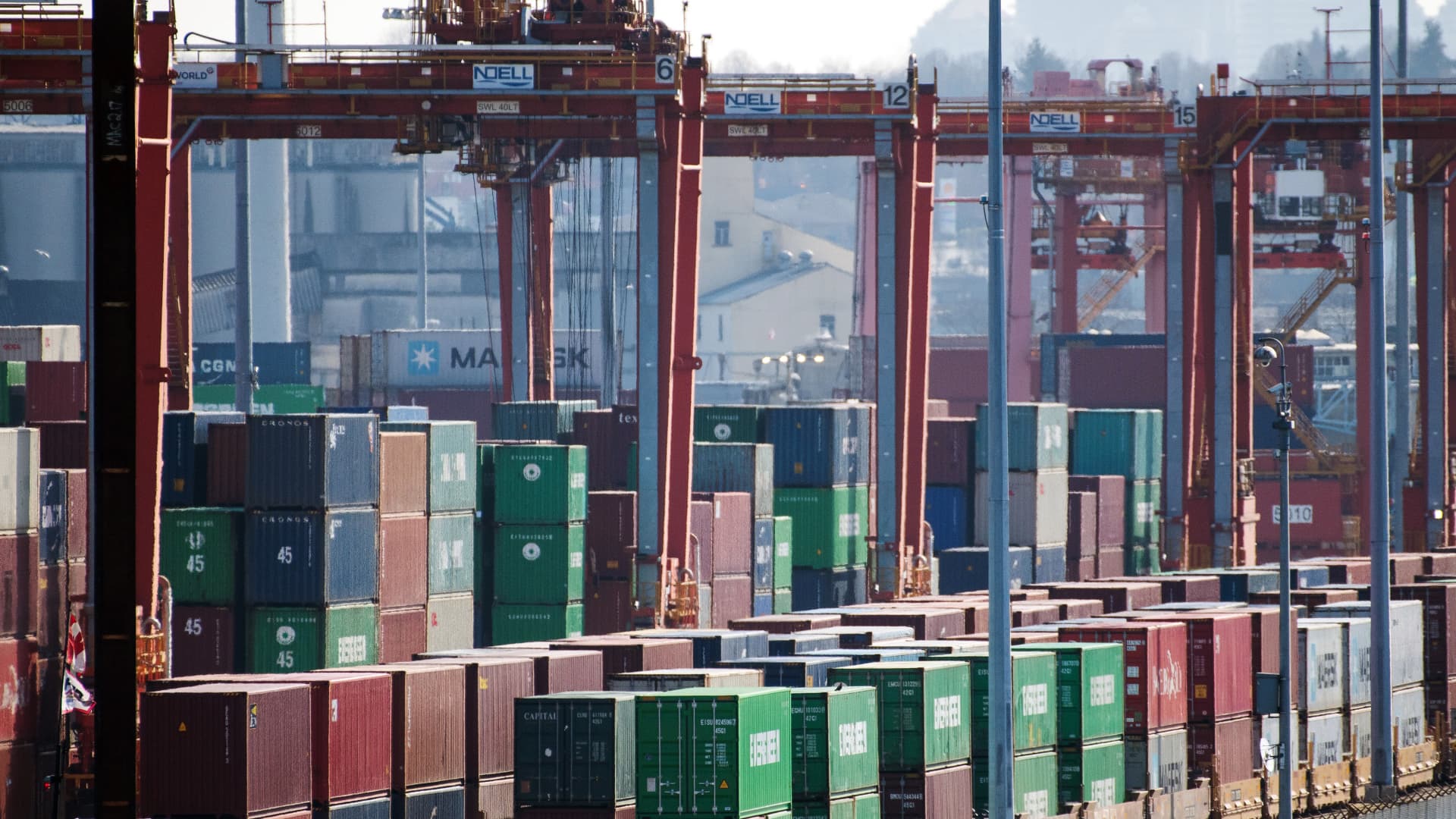Shipping containers are loaded onto rail cars at the Global Container Terminals Vanterm container terminal on Vancouver Harbour in Vancouver, British Columbia, Canada.
Bloomberg | Bloomberg | Getty Images
Weekly rail trade data from the Association of American Railroads shows the devastating impact that Canadian West Coast ports strike is having on freight rail cargo entering the U.S.
Year-over-year intermodal Canadian rail was down 46.2% last week as a result of the strike. Top sectors impacted include forest products such as lumber and wood products, oil and petroleum products, non-metallic minerals such as crushed stone, sand, stone, clay, and glass products, and chemicals.
The AAR said in a statement that while the July 4 holiday may have played a role in the trade decline, “this traffic decline is a tangible indicator of Western Canadian ports strike impact on rail customers and the larger North American economy. The longer the situation persists, the greater the impact to the North American supply chain.”
Approximately $572 million in container trade arrives daily in the U.S. from Canada, according to U.S. Census data. Between January 2022 and May 2023, total monthly U.S. goods imported from Canada ranged from $31 billion to nearly $41 billion. Top commodity imports for May included mineral fuels, vehicles, and computer-related machinery.
The International Longshoremen and Warehouse Union of Canada begin its strike on July 1. Negotiations between the ILWU Canada and the British Columbia Maritime Employers Association have been tense, with both sides speaking to federal mediators to hash out a deal.
The U.S. and Canada have a historically strong trade relationship: Each country is the other’s top trading partner. Approximately 20% of U.S. trade arrives in the Canadian ports of Vancouver and Prince Rupert, where strikes broke out after union leadership and industry representatives failed to reach a deal before a cooling off period expired. The Canadian Chamber of Commerce estimates $605 million in trade moves through one of those two ports daily.
It could take three to five days for every day the strike lasts for networks and supply chains to recover, according to an estimate from the Railway Association of Canada. This means if the strike were to end on its twelfth day, delays for rail containers can be anywhere from 36 to 60 days. This does not include the delays in vessels waiting to get processed, which would add multiple additional delays.

Vessel diversions plus containers on other vessels being reassigned as U.S. cargo will add volume to the US. rail system, according to Paul Brashier, vice president of drayage and intermodal at ITS Logistics. It will also add time and charges such as additional rail fees, customs fees, and port handling fees.
The drop in trade is a reflection of the vessels that have left Vancouver and Prince Rupert to divert their cargo to the United States. The volume of trade being disrupted has sparked supply chain concerns in the U.S.
ITS has switched both the U.S. West Coast and East Coast rail ramps to red in its freight index, signaling future congestion as a result of the strike.
“As container wait times in Western Canada increase due to the duration of the strike, that freight will overwhelm rail lines and ramps when it finally starts to transfer from the ocean terminals to the interior point rail ramps,” Brashier said.
VesselsValue data shows 14 container vessels currently anchored offshore at Vancouver and Prince Rupert, containing $7.6 billion in trade.
“A decent amount of product flows through Vancouver from Asia and is railed down to points like Chicago,” said Eric Byer, CEO of the National Association of Chemical Distributors. He said some members are now seeing three to four week delays because of the strike, but added that there is excess capacity in the marketplace so the current situation is not on the level of a crisis that would have emerged if U.S. West Coast ports had not recently reached a deal. “But [this is] still disconcerting. The strike can’t last for weeks or the strain on the supply chain will become challenging again,” Byer said.
Products that go into paints, coatings as well as acids from Asia, are most impacted, according to the National Association of Chemical Distributors.
US ports servicing diverted ships, despite what union says
ILWU president Willie Adams, who was back in Canada for the second time since July 4 to attend a union rally Sunday, told CNBC in a recent statement that union workers will not serve any rediverted vessels, but activity at U.S. ports indicates that is not the case. The vessels OOCL San Francisco, MSC Sara Elena, Hyundai Faith, and CMA CGM Medea have been serviced. However, it would be difficult for the ILWU to identify containers that had their final destinations changed because union workers do not have access to container information for security reasons.
The ILWU West Coast chapter in the U.S. did not respond to a request for comment.
A statement on Twitter posted by the Canadian Labor Minister on Tuesday said differences between the union and port ownership are not great enough for a work stoppage and he asked senior federal mediators to write up a deal and send it to him in 24 hours. Once the labor minister receives the deal he will send it to both parties and they have 24 hours to decide if they agree or not.
The government’s action would not stop the strike, and the union responded with sharp words for the Labor Minister.
“The federal government would not intervene to impose contract terms on the shipping companies, protecting Canadians from cost and disruption, and it’s sheer hypocrisy to now argue that government should force longshore workers back to work,” said ILWU Canada President Rob Ashton.
Wages have been a key sticking point in the failed talks, with the ILWU stressing that wages are not keeping up with inflation. It says real purchasing power of longshore wages has fallen 2.5% since 2017, and longshore wages have grown slower than wages in the overall Canadian economy.
On Wednesday, the Bank of Canada raised its benchmark interest rate to a 22-year high, of 5%, and provided hawkish commentary about more hikes potentially being needed in its effort to fight inflation, even as consumer prices have come down from last year’s highs.
In order to get the union back to work without a labor deal, the Canadian Parliament would have to be recalled, a politically unappealing option. If Parliament is recalled it would take several days and it needs a quorum in the room for the vote to be legal.
Steve Lamar, CEO of the American Apparel and Footwear Association, recently told CNBC any disruption in supply chains, this strike included, pose both inflationary and inventory challenges during peak shipping season. His group has called for a recall of Parliament to help overcome the biggest hurdle right now: accessing goods that are stuck on boats or being diverted to other ports.

